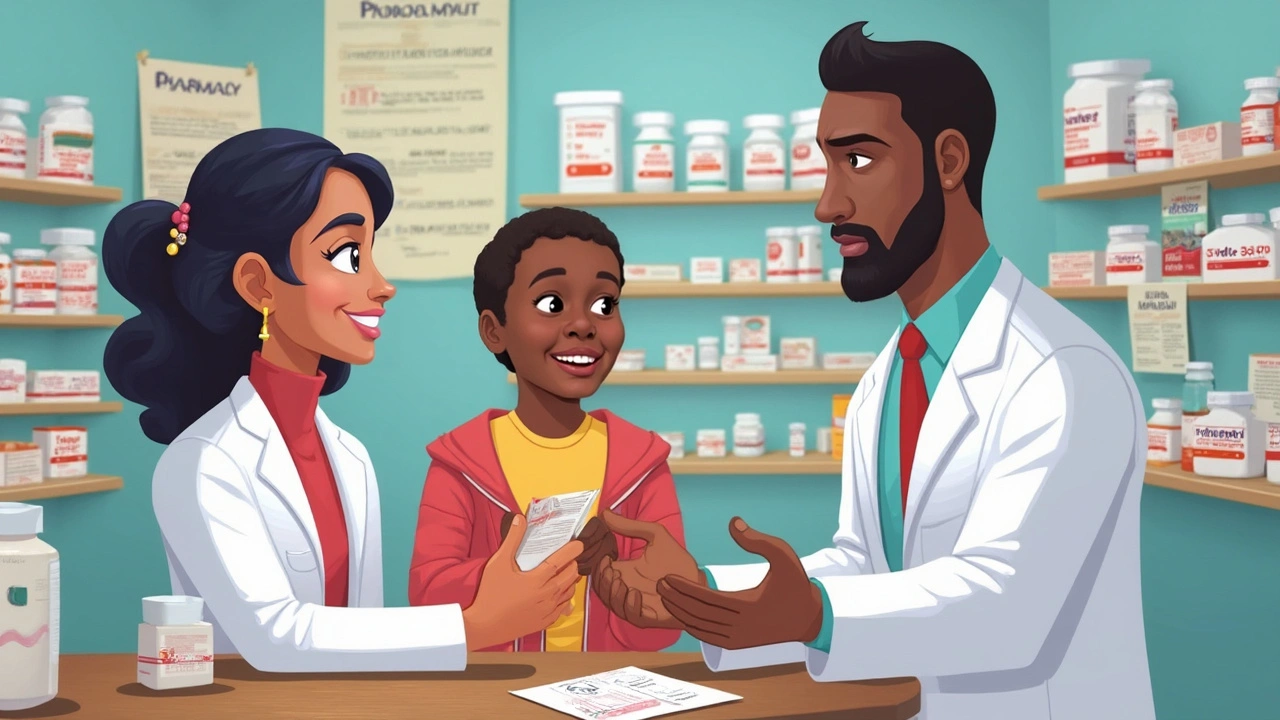
Picture this: a medicine so common you’ve probably got it stashed in your bathroom cabinet right now. Tylenol isn’t a fancy or rare solution—it’s what millions grab for headaches, fevers, or those everyday pains we all get. But have you ever stopped to wonder if you’re actually using it right? Or if it’s as safe as people think? The story of Tylenol isn’t just about relief; it’s about risk, mistaken beliefs, and a drug that quietly sits at the top of the world’s medicine charts.
Tylenol is the brand name for acetaminophen, a pain and fever reducer that shows up in everything from cold medicine to prescription combos. It’s not an anti-inflammatory, so don’t expect it to shrink a swollen ankle the way ibuprofen might. But for headaches, minor muscle aches, or those stubborn low-grade fevers—Tylenol is the quiet hero.
Here’s a surprising detail: Tylenol (or acetaminophen, if you’re looking at generics) was first approved way back in the 1950s. Since then, it’s become a household staple worldwide. In the US alone, folks buy over 25 billion doses every year—a fact straight from the Consumer Healthcare Products Association. You’ve probably seen it as gel caps, tablets, liquids, or quick-dissolving kids’ versions. Some cold and flu meds sneak acetaminophen into the mix too, so always peek at your labels. Because it often isn’t listed as “Tylenol”—the name hidden is “acetaminophen.”
How does it work? Tylenol travels to your brain, where it blocks certain chemicals—the prostaglandins—that tell you you’re hurting or have a fever. Because of how it works, Tylenol is often recommended for people who can’t take NSAIDs like ibuprofen or aspirin, especially those with sensitive stomachs or certain heart issues. But that doesn’t mean it’s perfect for everyone. The steady popularity hides a less obvious risk: you can’t always feel when you’re taking too much and, unlike ibuprofen, Tylenol doesn't fight inflammation.
One big myth I hear all the time: that Tylenol is risk-free. That’s not true at all. It’s one of the safest pain remedies out there if you follow the rules, but it’s also the leading cause of acute liver failure in the US, mainly because folks accidentally take more than they should. So, yes, Tylenol is a staple—and a necessity for many—but it’s not a license to toss the bottle back whenever you please.
So why do doctors and parents reach for Tylenol so often? Simple: it’s trusted, cheap, and usually easy on the stomach. This makes it a go-to for headaches, toothaches, muscle pain, minor arthritis pain, and fevers. It’s even what hospitals choose for women after C-sections, thanks to its safety record if given in the right dosages.
You might be surprised to find out that Tylenol is in almost every American home—research by the CDC in 2023 estimated that 7 in 10 US households have some form of acetaminophen on hand. Its reputation for being gentle enough for children is part of the reason. Pediatricians like Tylenol for babies over 2 months old (when dosed properly), especially since children’s ibuprofen isn’t safe for the very young.
Here’s where it gets tricky: Tylenol is sneaky. It hides in cold and cough syrups, sleep aids, prescription pain combos, and even allergy meds. Some people pop a cold pill, then reach for Tylenol, not realizing they’re doubling or even tripling up on acetaminophen. A Johns Hopkins study from 2022 showed that about 45% of accidental overdoses happen this way—people don’t realize what’s in their medicine cabinet.
Another fact: Tylenol won’t irritate your stomach or thin your blood as NSAIDs can, so it’s safer for people with ulcers or certain bleeding disorders. But there’s a twist; because it slips past our radar so easily, people with chronic headaches (migraine warriors, you know who you are) sometimes use it too often. And that can make your headaches worse in the long run—a fun fact called "rebound headache."
Animal lovers, take note: Dogs and cats should never, ever get Tylenol. Even a small amount can be deadly for pets. Seriously, just don’t risk it.

The story gets serious fast when you look at Tylenol’s risks. Here’s the headline: the most common cause of sudden liver failure in the US is from too much acetaminophen. That’s straight from the National Institutes of Health. It’s not the usual story about someone trying to hurt themselves—these overdoses often happen by accident. Maybe someone took Tylenol for a backache, added a cold med, then took a prescription painkiller with more acetaminophen inside. The liver just can’t keep up.
Adults should never take more than 4,000 milligrams a day (that’s 8 extra-strength 500mg pills). But experts now say if you have any liver troubles or drink alcohol regularly, you need to keep it lower—3,000 mg or less per day. Children need even less, and dosages always have to be matched to weight, not just age. The signs of trouble? Nausea, vomiting, confusion, yellowing skin, or pain in your upper right belly.
Rarer reactions can happen too: rashes, allergic reactions, and even serious skin disorders like Stevens-Johnson syndrome. That’s rare, but it needs a fast trip to the ER if you notice skin peeling off or strange rashes after taking Tylenol. Here’s a sobering quote from the FDA:
"Acetaminophen overdoses send more than 50,000 Americans to the emergency room each year, and over 100 people die annually from unintentional misuse."
If you suspect you’ve taken too much, don’t wait for symptoms. The damage often starts quietly and only shows up a day or two later. There’s actually an antidote (N-acetylcysteine), but it works best if given early.
One more thing: combining Tylenol with alcohol really puts the liver at risk. Even small amounts of alcohol can make overdose more likely. And people who fast, are malnourished, or have underlying liver or kidney diseases are much more vulnerable. On the flip side, most people can use Tylenol safely from time to time, even daily for a short period, if they stick to the right dose.
So, how do you make Tylenol work for you without the risks? Easy—follow a few simple rules. First, always read the package label. You might be surprised how many cold, flu, and pain combos include acetaminophen. If you’re not sure, there’s usually a toll-free number on the box, so just call and ask.
The best way to avoid trouble is to write down every pill, syrup, or supplement you take while you’re sick. This helps you catch any duplicates before it’s too late. Doctors recommend avoiding more than one product with acetaminophen at a time. That’s especially important for parents: keep a dosing chart handy for your kid, based on their weight (not just age). Check with your pediatrician before switching between kids’ Tylenol and Motrin to avoid confusion or stacking too much medicine.
Tylenol is often best taken with or after food, although it won’t hurt your stomach like NSAIDs. Swallow pills with a big glass of water, and don’t mix different forms—if you drank a syrup, don’t immediately pop a pill.
If you take Tylenol daily for chronic pain, give your body a break every few weeks if possible, or talk to your provider about regular liver checks. It’s also smart to keep the poison control number handy at home, just in case someone unintentionally takes too much (especially if you’re taking care of young kids or older adults).
Toss expired Tylenol—old acetaminophen isn’t just weaker; it could be unsafe. And never double up to “catch up” if you missed a dose. If you need more than the standard dose to get relief, it’s time to check with your doctor about what’s really going on.
If you want to avoid medicine errors while caring for your family, try these simple ideas:
Adults who drink often or have hepatitis, fatty liver, or cirrhosis need even less Tylenol. Some docs suggest limiting to 2,000mg (that’s just 4 extra-strength pills) per day, and never more without doctor OK.
If you have a sensitivity to common pain medicine or are pregnant, Tylenol is often the first choice. But during pregnancy, always clear it first with your OB. Recent data is mixed, but occasional use as directed is still generally believed to be the safest pain option available while pregnant.

Tylenol’s story isn’t done. There’s research now exploring acetaminophen’s effects on emotions. Wild as it sounds, some studies at Ohio State found that acetaminophen may dull not just physical pain, but also blunt emotional highs and lows. Don’t worry, you’re not turning into a robot with a headache pill—but the effect is small and mostly seen in lab studies, not real life.
Another quirky fact: Tylenol doesn’t work for everyone. Scientists aren’t totally sure why, but it may be a mix of genetics and the type of pain you’re feeling. Some folks find it does nothing for their back pain but works like magic for a fever or headache.
New formulas are also hitting shelves—look for rapid-release gels, dissolving powders, and even Tylenol formulas meant for sleep support, mixed with things like diphenhydramine. But always check for that acetaminophen content before you buy a combo product.
Globally, Tylenol goes by different names—paracetamol in Europe, for example—but it’s the same medication. And it’s on the World Health Organization’s list of “essential medicines,” meaning it’s considered safe and effective enough for use everywhere.
Drugmakers, including Tylenol’s parent company Johnson & Johnson, now print “acetaminophen” in bold on bottles to help consumers spot it before mixing meds. This started after a wave of accidental overdoses in the late 2000s, and it’s made a real difference in cutting down on mistakes, according to the FDA.
Here’s what’s on the research horizon: scientists are digging into how acetaminophen interacts with other medicines, ways to protect the liver, and even smarter packaging aimed at preventing accidental kid overdoses. Some over-the-counter apps even scan your barcodes and keep a diary for you, so you always know how much Tylenol you’ve had. Pretty smart, if you ask me.
Tylenol is a simple medicine with a complicated story. It sits unassumingly on our shelves, one of the world’s most-used drugs. Used right, it’s often safe and helpful—sometimes the best choice for pain or fever relief, especially when others are off-limits. But like most things, the risks come from what you don’t know and what you forget to check. So next time you reach for that little white bottle, take a second look—you might be holding something powerful, and knowing the facts is the key to unlocking its benefits without the risks.
Ah, the humble acetaminophen, the unsung hero of our medicine cabinets-so ubiquitous yet so dramatically misunderstood. You stroll into the pharmacy, grab a bottle, and think you’re immune to the perils that lurk in everyday meds. Little do you realize that this seemingly innocent white tablet holds the power to topple livers if mishandled. The article rightly points out the sheer volume we consume, but what truly stings is the cavalier attitude many have toward dosage. It’s as if we treat it like candy, popping a couple of pills after a long day without a second thought. The silent menace of hidden acetaminophen in cold syrups and combo drugs only fuels this reckless ballet. When you combine it with alcohol, you’re not just dancing on a razor’s edge-you’re practically inviting disaster. The statistics about liver failure are not just numbers; they’re real lives upended by a simple oversight. So next time you reach for that bottle, pause, reflect, and respect the chemistry you’re about to unleash.
Indeed, the discourse surrounding acetylphenen warrants an exposition of unparalleled thoroughness, for it is not merely a pharmaceutical adjunct but a cultural artifact that has permeated the very fabric of contemporary health praxis. Commencing with its historical inauguration in the mid‑twentieth century, the compound swiftly ascended to a status of ubiquitous availability, a testament to both its efficacy and the astute marketing stratagems of its progenitors. Yet, beneath the veneer of convenience lies a labyrinthine web of pharmacokinetic intricacies, wherein hepatic metabolism is orchestrated by the cytochrome P450 ensemble, an enzymatic consortium whose capacity is not infinite. Consequently, the insidious accumulation of N‑acetyl‑p‑benzoquinone imine (NAPQI) in the hepatocellular milieu precipitates oxidative stress, culminating in necrosis when the glutathione reserves are depleted. The demographic heterogeneity of susceptibility further complicates dosing paradigms; for instance, individuals with chronic alcoholism exhibit a downregulated glutathione synthesis pathway, thereby amplifying the peril of hepatotoxicity. Moreover, the proclivity of manufacturers to embed acetaminophen within polypharmacy regimens-ranging from antitussives to analgesic combinations-obfuscates the consumer's ability to accurately quantify total intake. A salient illustration of this phenomenon is the prevalence of covert acetaminophen concentrations in ostensibly unrelated over‑the‑counter remedies, a practice that has been implicated in a nontrivial proportion of unintentional overdoses, as corroborated by epidemiological surveys conducted in tertiary care facilities. In light of these considerations, it becomes incumbent upon both prescribers and patients to engage in meticulous reconciliation of medication inventories, employing tools such as dosing charts calibrated to body mass index and hepatic function indices. Additionally, the advent of novel drug‑delivery systems, including rapid‑release gels and nanoparticle‑based formulations, promises to ameliorate the temporal constraints of absorption, yet they must be appraised with circumspection to preclude inadvertent supra‑therapeutic exposure. Therefore, while acetaminophen remains a cornerstone of analgesic therapy, its administration must be governed by an ethos of vigilant stewardship, undergirded by an appreciation of its biochemical idiosyncrasies and the sociomedical contexts that precipitate its misuse.
I’ve always appreciated how acetaminophen is a gentle option for folks who can’t handle NSAIDs, but the article does a solid job reminding us that “gentle” doesn’t mean “no‑risk.” It’s easy to forget that many of the combo cold medicines we reach for already have a dose of it inside. I try to keep a simple list of what each family member is taking, especially when we’re juggling kids’ meds and my own occasional headaches. Staying aware of the total daily milligram count has saved me from a potential liver scare, and it’s something anyone can do with a quick glance at the label.
That’s a solid habit, Chris. I’d add that setting a phone alarm for each dose can be a game‑changer when you’re juggling work and family. Also, using the original packaging and a dedicated dosing cup helps avoid mixing syrups with tablets. If you ever notice you’re reaching for that extra pill because the pain isn’t gone, it might be time to chat with a doc about alternative options rather than just cranking up the dose.
From a purely analytical perspective, the data underscores a paradox: the most widely used analgesic is also the leading cause of drug‑induced liver injury. This juxtaposition is a fertile ground for policy‑driven interventions, perhaps mandating clearer labeling or limit caps on acetaminophen per package. Such measures could mitigate the inadvertent cumulative dosing that currently fuels the overdose statistics.
I think its super important to write down all meds you take its easy to forget stuff like hidden acetaminophen especially in cold meds its a good habit and can save lives dont forget to check the label each time you pick up a bottle
Never skip reading the label.
💊💡🔬 FYI, if you’re tracking total acetaminophen intake, consider using a health‑tech app that scans barcodes – it’ll auto‑log mg dosages and flag when you’re nearing that 4 g ceiling. It’s especially handy for clinicians who need to monitor polypharmacy in patients with comorbidities. 🎯📱
Oi mate, stop actin like you dont know the rules – this ain't no free for all. If you keep mashin down Tylenol like it's a game, you'll end up in the UK hospital faster than you can say "proper dosage". Keep yer head on a swivel and read the label, innit?
Everyone, please stop the misinformation. The maximum daily dose for a healthy adult is 4,000 mg, not the vague "a few tablets" many suggest. Exceeding this limit is not a minor oversight; it directly endangers hepatic function. Also, the article should have emphasized that the label must list "acetaminophen" prominently, not hidden in fine print. Proper dosage calculations based on weight are essential for pediatric patients. Let’s stick to the facts and stop glorifying reckless self‑medication.
While the article covers most bases, a few minor errors slipped in-for instance, it said "acetaminophen" is on the WHO essential meds list, but the proper term there is "paracetamol." Also, watch out for the typo in "N‑acetyl‑p‑benzoquinone imine"-the dash should be after the "p" only. Small details matter when discussing safety.